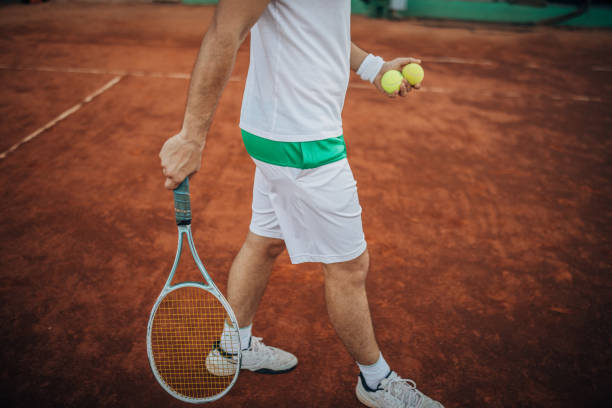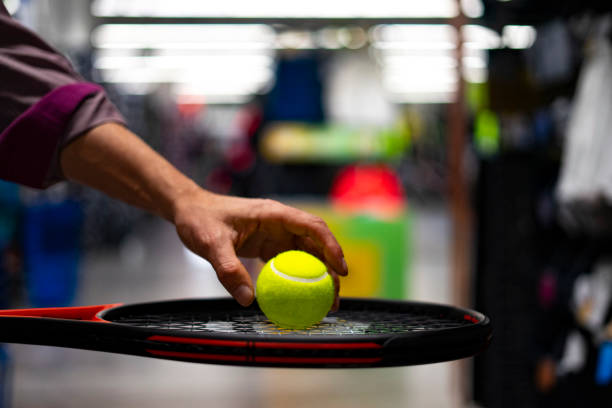Πόσο διαρκεί ένας αγώνας τένις; Ο καλύτερος οδηγός(2023)

Το τένις, ένα αγαπημένο άθλημα που παίζεται από εκατομμύρια σε όλο τον κόσμο, έχει συναρπάσει τους θαυμαστές με τους συναρπαστικούς αγώνες και το έντονο παιχνίδι του. Μια συνηθισμένη ερώτηση που προκύπτει συχνά είναι, “Πόση διάρκεια διαρκεί ένας αγώνας τένις; Είτε είστε έμπειρος θαυμαστής είτε είστε περίεργοι αρχάριοι, η κατανόηση των διάφορων παραγόντων που συμβάλλουν στη διάρκεια ενός αγώνα τένις μπορεί να ενισχύσει την εκτίμησή σας για το παιχνίδι. Σε αυτό το άρθρο, θα εμβαθύνουμε στις λεπτομέρειες του Πόσο διαρκούν οι αγώνες τένις;, θα εξερευνήσουμε διαφορετικές μορφές και θα ρίξουμε φως στις μεταβλητές που κάνουν κάθε αγώνα μοναδικό.
Οι αγώνες τένις είναι γνωστοί για τη δυναμική τους φύση, όπου οι παίκτες συμμετέχουν σε ράλι, σερβίρουν δυνατά σουτ και κάνουν στρατηγική για να ξεπεράσουν τους αντιπάλους τους. Η διάρκεια ενός αγώνα τένις μπορεί να ποικίλλει σημαντικά βάσει πολλών παραγόντων και δεν είναι ασυνήθιστο οι αγώνες να διαρκούν οπουδήποτε από λιγότερο από μία ώρα έως αρκετές ώρες.
Παράγοντες που επηρεάζουν – Πόσο διαρκεί ένας αγώνας τένις;
Η διάρκεια ενός αγώνα τένις μπορεί να ποικίλλει σημαντικά με βάση αρκετούς βασικούς παράγοντες. Κατά μέσο όρο, ένας τυπικός αγώνας μονάδων σε επαγγελματικό επίπεδο μπορεί να διαρκέσει από 1,5 έως 3 ώρες. Ωστόσο, υπάρχουν μεταβλητές που μπορεί να κάνουν τις αντιστοιχίσεις να είναι μικρότερες ή μεγαλύτερες από αυτό το εύρος.
| Μορφή | Μέση διάρκεια (λεπτά) |
|---|---|
| Best-of-3 | 90 |
| Best-of-5 | 180 |
| Ο μεγαλύτερος αγώνας όλων των εποχών | 11 ώρες και 5 λεπτά |
Η διάρκεια ενός αγώνα τένις μπορεί να ποικίλλει ανάλογα με διάφορους παράγοντες, όπως το επίπεδο παιχνιδιού, την επιφάνεια του γηπέδου και τον αριθμό των τάι μπρέικ. Ωστόσο, η μέση διάρκεια ενός αγώνα σε κάθε μορφή εμφανίζεται στον παραπάνω πίνακα.
Ακολουθεί μια πιο λεπτομερής εξήγηση για κάθε μορφή:
- Best-of-3: Αυτή είναι η πιο κοινή μορφή που χρησιμοποιείται σε τουρνουά τένις. Ο πρώτος παίκτης που θα κερδίσει 2 σετ κερδίζει τον αγώνα. Εάν το σκορ είναι ισόπαλο σε 1 σετ το κάθε κομμάτι, παίζεται ένα τρίτο σετ.
- Best-of-5: Αυτή η μορφή χρησιμοποιείται σε τουρνουά Grand Slam και σε ορισμένα άλλα μεγάλα τουρνουά. Ο πρώτος παίκτης που θα κερδίσει 3 σετ κερδίζει τον αγώνα. Εάν το σκορ είναι ισόπαλο σε 2 σετ το κάθε ένα, παίζεται ένα πέμπτο σετ.
- Ο μεγαλύτερος αγώνας όλων των εποχών: Ο μεγαλύτερος αγώνας τένις που παίχτηκε ποτέ ήταν μεταξύ του John Isner και του Nicolas Mahout στο Wimbledon το 2010. Ο αγώνας διήρκεσε 11 ώρες και 5 λεπτά σε διάστημα τριών ημερών.
Επιφάνεια Δικαστηρίου
Ο τύπος της επιφάνειας του γηπέδου παίζει καθοριστικό ρόλο στον καθορισμό της διάρκειας του αγώνα. Τα χωμάτινα γήπεδα, για παράδειγμα, τείνουν να επιβραδύνουν το παιχνίδι λόγω υψηλότερων αναπηδήσεων της μπάλας και μεγαλύτερης διάρκειας ράλι. Από την άλλη πλευρά, τα γήπεδα με χόρτο συχνά οδηγούν σε ταχύτερους πόντους, μειώνοντας ενδεχομένως τον αγώνα.
Επιπεδο ΙΚΑΝΟΤΗΤΑΣ
Οι αγώνες που περιλαμβάνουν επαγγελματίες παίκτες μπορούν να διαρκέσουν περισσότερο λόγω του υψηλού επιπέδου δεξιοτήτων και της ικανότητάς τους να προβλέπουν τις κινήσεις του αντιπάλου τους. Αντίθετα, οι αγώνες μεταξύ αρχαρίων ή ερασιτεχνών μπορεί να έχουν μικρότερη διάρκεια.
Στυλ Παίζοντας
Το στυλ παιχνιδιού ενός παίκτη επηρεάζει σημαντικά τη διάρκεια του αγώνα. Οι επιθετικοί παίκτες που συχνά αναζητούν νικητές μπορεί να τερματίσουν γρήγορα τους πόντους, ενώ οι αμυντικοί παίκτες διαπρέπουν στην παράταση των ράλι και στην επέκταση της διάρκειας του αγώνα.
Καιρικές συνθήκες
Εξωτερικοί παράγοντες όπως ο καιρός μπορούν να επηρεάσουν τη διάρκεια του αγώνα. Καθυστερήσεις βροχής ή υπερβολική ζέστη ενδέχεται να διακόψουν το παιχνίδι, προκαλώντας δυνητικά πολλές ημέρες αγώνων.
Διαφορετικές μορφές αγώνων τένις
| Μορφή | Περιγραφή |
|---|---|
| Singles | Ένας παίκτης εναντίον άλλου παίκτη. |
| Διπλά | Δύο παίκτες σε κάθε ομάδα έναντι δύο παικτών στην άλλη ομάδα |
| Μικτά διπλά | Ένας άντρας και μια γυναίκα σε κάθε ομάδα εναντίον ενός άνδρα και μιας γυναίκας στην άλλη ομάδα |
| Ταϊ-μπρέικ | Παίζεται ένα παιχνίδι ξαφνικού θανάτου για να κριθεί ένα σετ που είναι ισόπαλο 6-6. |
| Best-of-3 | Ο πρώτος παίκτης ή ομάδα που θα κερδίσει δύο σετ κερδίζει τον αγώνα. |
| Best-of-5 | Ο πρώτος παίκτης ή ομάδα που θα κερδίσει τρία σετ κερδίζει τον αγώνα. |
| Round robin | Όλοι οι παίκτες ή οι ομάδες παίζουν μεταξύ τους μία φορά. |
| Ρίχνω αναίσθητο | Παίκτες ή ομάδες αποκλείονται μετά την ήττα ενός αγώνα. |
| Σύνδεσμος | Οι παίκτες ή οι ομάδες παίζουν μεταξύ τους πολλές φορές και οι κορυφαίες ομάδες προκρίνονται στα πλέι οφ. |
Αγώνες μονού
Σε αγώνες μονά, όπου δύο παίκτες ανταγωνίζονται μεταξύ τους, ο αγώνας είναι συνήθως ο καλύτερος από τα τρία σετ. Ωστόσο, οι μονοί αγώνες Grand Slam είναι καλύτεροι από πέντε σετ, γεγονός που μπορεί να παρατείνει σημαντικά τη διάρκεια του αγώνα.
Αγώνες διπλών
Στους διπλούς αγώνες συμμετέχουν δύο ομάδες των δύο παικτών η καθεμία. Αυτοί οι αγώνες μπορεί να είναι πιο σύντομοι από τους μονούς λόγω της συλλογικής φύσης του παιχνιδιού και των πιο γρήγορων τερματισμών πόντων.
Τουρνουά Grand Slam
Τα τουρνουά Grand Slam, η κορυφή των διοργανώσεων τένις, είναι γνωστά για τους εκτεταμένους αγώνες τους. Με τα καλύτερα από τα πέντε σετ φορμά, οι παίκτες συχνά επιδεικνύουν την αντοχή και την ψυχική τους δύναμη σε αυτά τα τουρνουά.
Στρατηγικές που επηρεάζουν το μήκος αγώνα

Επιθετικό παιχνίδι εναντίον αμυντικού παιχνιδιού
Οι παίκτες που υιοθετούν έναν επιθετικό τρόπο παιχνιδιού στοχεύουν να τερματίσουν γρήγορα τους πόντους, οδηγώντας ενδεχομένως σε μικρότερους αγώνες. Αντίθετα, οι αμυντικοί παίκτες επικεντρώνονται στη συνέπεια και τα παρατεταμένα ράλι, τα οποία μπορούν να παρατείνουν τη διάρκεια του αγώνα.
Παρατεταμένα συλλαλητήρια
Τα μεγάλα ράλι, όπου οι παίκτες συμμετέχουν σε πολλές ανταλλαγές, μπορούν να συμβάλουν σημαντικά στη διάρκεια του αγώνα. Αυτές οι ανταλλαγές δοκιμάζουν τη φυσική κατάσταση και την ψυχική ανθεκτικότητα των παικτών.
Tiebreakers και αποφασιστικά σετ
Τα tiebreakers, που εισήχθησαν για να αποτρέψουν τα μεγάλα σετ, προσθέτουν ένα στοιχείο ενθουσιασμού. Ωστόσο, εάν οι αγώνες φτάσουν σε ένα καθοριστικό σετ, η συνολική διάρκεια μπορεί να αυξηθεί.
Η επιρροή της τεχνολογίας στη διάρκεια του αγώνα
Τεχνολογία Hawk-Eye
Η τεχνολογία Hawk-Eye επιτρέπει στους παίκτες να αμφισβητούν τις κλήσεις, συμβάλλοντας σε μικρές διακοπές. Ενώ βελτιώνει την ακρίβεια, μπορεί επίσης να παρατείνει τον χρόνο αγώνα.
Βολή Ρολόγια
Τα ρολόγια βολής, που έχουν εφαρμοστεί για την εξασφάλιση έγκαιρων σερβίς, έχουν επιταχύνει το παιχνίδι, αποτρέποντας μεγάλες παύσεις μεταξύ των πόντων.
Συχνές ερωτήσεις σχετικά με το πόσο διαρκεί ένας αγώνας τένις;
Πόσο διαρκεί ένας τυπικός ερασιτεχνικός αγώνας τένις;
Οι ερασιτεχνικοί αγώνες τένις μπορεί να διαφέρουν σε μεγάλο βαθμό σε διάρκεια. Ένας περιστασιακός αγώνας μονά μπορεί να διαρκέσει περίπου 1 έως 1,5 ώρα, ενώ οι διπλοί αγώνες μπορεί να είναι μικρότεροι λόγω του σχήματος της ομάδας.
Μπορεί ένας αγώνας τένις να διαρκεί μέρες;
Αν και είναι σπάνιο, έχουν γίνει αγώνες μαραθωνίου τένις. Ο μεγαλύτερος αγώνας στην ιστορία του τένις διήρκεσε για περισσότερες από 11 ώρες, και διήρκεσε τρεις ημέρες στο Wimbledon το 2010.
Οι μακρύτερες αντιστοιχίες σημαίνουν υψηλότερη ποιότητα;
Οχι απαραίτητα. Ενώ οι μεγαλύτεροι αγώνες μπορούν να επιδείξουν την αντοχή των παικτών, οι πιο σύντομοι αγώνες μπορούν επίσης να επιδείξουν εξαιρετική ικανότητα και στρατηγική.
Γιατί οι αγώνες στα χωμάτινα γήπεδα είναι συχνά μεγαλύτεροι;
Τα χωμάτινα γήπεδα επιβραδύνουν τη μπάλα και ενθαρρύνουν μεγαλύτερα ράλι, καθιστώντας πιο δύσκολο το χτύπημα των νικητών. Αυτό οδηγεί σε εκτεταμένους βαθμούς και, κατά συνέπεια, μεγαλύτερους αγώνες.
Ποιος είναι ο πιο γρήγορος τρόπος για να κερδίσετε έναν αγώνα τένις;
Ένας παίκτης με ισχυρό σερβίς και επιθετικό παιχνίδι μπορεί να κερδίσει πόντους γρήγορα, οδηγώντας σε μια γρήγορη νίκη.
Πώς επηρεάζει ο κανόνας του τάι μπρέικ τη διάρκεια του αγώνα;
Τα tiebreakers χρησιμοποιούνται για να αποφασίσουν σετ που φτάνουν ένα συγκεκριμένο όριο βαθμολογίας. Μπορούν να συντομεύσουν τη διάρκεια του αγώνα αποτρέποντας τα μεγάλα σετ.
Συμπέρασμα – Πόσο διαρκεί ένας αγώνας τένις;
Στον κόσμο του τένις, η διάρκεια ενός αγώνα είναι μια δυναμική πτυχή που επηρεάζεται από μυριάδες παράγοντες. Από τα στυλ παικτών και τις επιφάνειες του γηπέδου μέχρι τις μορφές αγώνων και τις απροσδόκητες μεταβλητές, κάθε αγώνας έχει μια μοναδική ιστορία να πει. Είτε παρακολουθείτε έναν τελικό Grand Slam που κόβει τα νύχια είτε παίζετε ένα φιλικό παιχνίδι στο τοπικό σας γήπεδο, η κατανόηση των περιπλοκών της διάρκειας του αγώνα προσθέτει βάθος στην εμπειρία σας στο τένις.






